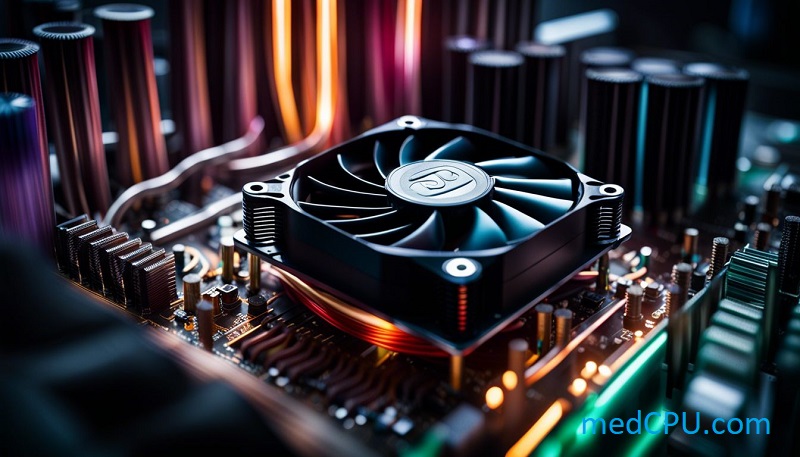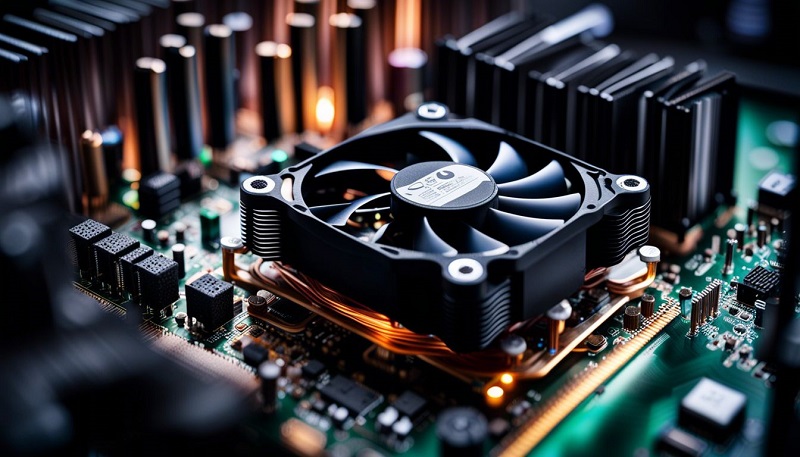Do Cpu Coolers Come With Thermal Paste?
Ever wondered if CPU coolers come with thermal paste? We’ve been there too, asking the same question amidst the intricate world of computer hardware. After digging deep into this topic, we’ve found a comprehensive answer to your query! Dive into our enlightening blog post and discover all you need to know about CPU coolers and their magical companion – thermal paste.
Overview of CPU Coolers
Do you ever wonder if your CPU cooler comes with thermal paste? Well, we’ve been there too. In fact, many people find themselves in a similar situation when building or upgrading their computers. The good news is that we’ve done the research for you and have all the answers you need. So let’s dive into the world of CPU coolers and find out what you need to know about thermal paste!
Types of CPU coolers
There are several types of CPU coolers available in the market, each having its unique design and working mechanism. The two major ones are air coolers and liquid (or water) coolers.
Air coolers generally use a fan to dissipate heat that’s generated by your processor. They’re relatively cheaper, easier to install, have fewer maintenance issues, and can keep most CPUs sufficiently cooled under normal operating conditions.
On the other hand, liquid coolers employ a completely different approach to cooling. These devices utilize coolant-filled tubes or capsules that draw heat away from the CPU towards a radiator where it is then expelled by fans.
Though pricier and slightly tricky to set up than their air counterparts, they provide better cooling performance – an advantage especially noticeable during heavy tasks like gaming or when overclocking your CPU.

Importance of thermal paste
Thermal paste plays a critical role in CPU cooling systems – one that should not be underestimated. It’s crucial for improving heat transfer from the actual processor to the cooler.
This thermal compound works by filling tiny air gaps between the two surfaces, contributing significantly to better heat dissipation.
Without good quality thermal paste application, even high-end coolers and fans will struggle to keep CPU temperatures down during intense usage or overclocking. On the other end of things, using an inappropriate amount can block your system.
So it’s essential we find balance—enough thermal interface material to ensure excellent heat conductivity but not so much that it creates a mess and potentially damage parts. Knowing this value is what makes aftermarket cooling solutions often more advantageous compared with stock heatsinks pre-applied with lower-quality paste.
In conclusion, thermal paste is invaluable for maintaining optimal CPU temperature and extending the lifespan of our processors due to its role in aiding efficient heat transfer through its good heat conductivity properties.
It may seem like just another element in our PC setup, but don’t overlook how important this small detail is when considering overall performance outcomes and building longevity!
Do CPU Coolers Come with Thermal Paste?
Most CPU coolers come with thermal paste included.
Yes, most CPU coolers come with thermal paste
We should note that the vast majority of CPU coolers available in today’s market come packaged with thermal paste. This is a critical substance designed to facilitate good heat conductivity between the actual processor and its cooler, essentially acting as an effective bridge for heat transfer.
The thermal compound is either pre-applied on the baseplate of the cooler (in the case of stock heatsinks) or provided separately in a small tube.
Interestingly, many people often express concerns about whether this pre-applied paste is up to par with aftermarket solutions in terms of quality and performance, but it really depends on many factors including your usage scenario.
For most average users operating their CPUs within standard conditions, this factory-supplied compound does perform satisfactorily well at dissipating heat from the CPU to its cooling system.
However, if you’re into overclocking or simply demand optimum cooling efficiency from your setup, you might want to explore high-quality aftermarket alternatives.
Quality of pre-applied thermal paste
The quality of pre-applied thermal paste can vary depending on the manufacturer and type of CPU cooler. In general, most CPU coolers come with pre-applied thermal paste that is sufficient for normal usage.
However, it may not be the highest quality paste available.
Using a high-quality thermal paste can improve heat transfer between the CPU and the cooler, resulting in lower temperatures and better overall performance. Aftermarket thermal pastes often offer better heat conductivity and may provide more consistent results compared to stock options.
It’s important to note that even with pre-applied thermal paste, proper application is crucial for optimal cooling performance. Ensuring that the baseplate of the cooler makes good contact with the actual processor is essential for effective heat transfer.
Do CPU coolers come with thermal paste Reddit?
Benefits of Using Thermal Paste
Using thermal paste has several benefits. It improves heat transfer between the CPU and the cooler, resulting in lower CPU temperatures.
Improves heat transfer
Using thermal paste between the CPU and the cooler can significantly improve heat transfer. Thermal paste fills in microscopic imperfections on the surfaces of both the CPU and cooler, creating a smoother contact area that promotes better heat conductivity.
This allows for a more efficient transfer of heat from the CPU to the cooler, helping to reduce temperatures during operation. By ensuring optimal heat transfer, you can prevent overheating and maintain better overall performance and longevity for your processor.
Whether using stock coolers or aftermarket solutions, applying high-quality thermal paste is essential for effective CPU cooling.
Reduces CPU temperatures
Using thermal paste between your CPU and cooler can significantly reduce CPU temperatures. Thermal paste is a substance with a high thermal conductivity that helps to fill in any microscopic imperfections on the surface of the CPU and cooler.
By creating better contact between these two surfaces, thermal paste allows for more efficient heat transfer.
When the processor generates heat during operation, the thermal paste helps to dissipate it from the CPU to the cooler. Without thermal paste, there can be air gaps or uneven contact between the surfaces, which impairs heat transfer and leads to higher CPU temperatures.
By ensuring the proper application of thermal paste, you can achieve lower overall temperatures for your CPU. This is particularly important when overclocking or using high-performance CPUs that generate more heat.
When Should You Replace Thermal Paste?
Thermal paste should be replaced if you notice higher CPU temperatures, increased noise from the cooling fan, or after a few years of use.
Signs of degraded thermal paste
Over time, the thermal paste can deteriorate and lose its effectiveness. One sign of degraded thermal paste is an increase in CPU temperatures. If you notice that your computer is running hotter than usual or experiencing frequent thermal shutdowns, it may be a sign that the thermal paste needs to be replaced.
Another indication of degraded thermal paste is a buildup of dust and dirt around the CPU cooler. As the paste ages, it can become dry and brittle, making it less effective at transferring heat away from the processor.
It’s important to regularly check and replace your thermal paste to ensure optimal cooling performance for your CPU.
Recommended replacement intervals
We recommend replacing the thermal paste on your CPU cooler every 2 to 3 years. Over time, the thermal paste can dry out and lose its effectiveness in transferring heat between the CPU and the cooler.
This can lead to higher temperatures and reduced cooling performance. By regularly replacing the thermal paste, you can ensure optimal heat transfer and maintain lower CPU temperatures.
However, it’s important to note that replacement intervals may vary depending on usage and environmental factors. If you frequently overclock your CPU or live in a particularly hot climate, you may want to consider more frequent replacements.
Additionally, if you notice any signs of degraded thermal paste such as dried-out or cracked consistency, it’s recommended to replace it right away.
Regularly monitoring your CPU temperatures is also a good practice for determining when it’s time to replace the thermal paste. If you notice consistently high temperatures or sudden spikes in temperature during normal usage, it may be an indication that the thermal compound needs to be replaced.
Aftermarket Thermal Paste vs Stock
Aftermarket thermal paste offers better heat conductivity and performance compared to the stock thermal paste that comes with most CPU coolers.
Pros and cons of aftermarket thermal paste
Aftermarket thermal paste offers several advantages over stock thermal paste. One major advantage is the quality of the compound itself. Aftermarket thermal pastes often contain higher quality materials such as metal particles or ceramic compounds, which help to improve heat conductivity and transfer more effectively than standard pre-applied pastes.
This can lead to lower CPU temperatures and better overall cooling performance.
Another benefit of aftermarket thermal paste is the ability to choose a specific brand or formula that suits your needs. Different thermal pastes have varying levels of viscosity, application methods, and durability.
By selecting an aftermarket option, you have more control over the characteristics of the paste you use for your CPU cooler.
However, there are also some drawbacks to consider with aftermarket thermal paste. One potential issue is that applying it yourself can be trickier than using pre-applied paste on a stock cooler.
It requires careful application techniques to ensure an even spread and optimal coverage without air bubbles or excess material.
Performance differences
When it comes to thermal paste, there are two options: using the pre-applied thermal paste that comes with your CPU cooler or opting for aftermarket thermal paste. While pre-applied thermal paste is convenient and does a decent job, aftermarket thermal paste can offer better performance.
Aftermarket thermal pastes often boast higher-quality ingredients that contribute to improved heat transfer between the CPU and the cooler. This can result in lower CPU temperatures and better overall cooling performance.
Additionally, some aftermarket pastes have unique properties like high heat conductivity or longer-lasting formulations that can further enhance their effectiveness.
Overall, if you’re looking for optimal cooling performance or planning on overclocking your processor, investing in a high-quality aftermarket thermal paste might be worth considering.

How to Apply Thermal Paste
To apply thermal paste, begin by cleaning the CPU and cooler surfaces with a lint-free cloth and isopropyl alcohol.
Step-by-step guide
To apply thermal paste on your CPU cooler, start by cleaning off any old thermal paste residue from both the CPU and cooler using isopropyl alcohol and a lint-free cloth. Once clean, squeeze a small amount of thermal paste onto the center of the CPU.
The amount should be about the size of a pea. Next, spread the paste evenly over the surface of the CPU using a plastic card or spatula. Be careful not to use too much pressure as this can create air bubbles.
Finally, carefully place your CPU cooler onto the processor, making sure it aligns properly with the mounting brackets or screws. Gently apply even pressure to secure it in place and allow for optimal heat transfer between the two surfaces.
Dos and don’ts:
- Do Ensure that both surfaces are clean before applying the new thermal paste.
- Don’t spread or push down hard on the thermal paste once applied.
Dos and don’ts
When applying thermal paste, there are a few dos and don’ts to keep in mind. First, do clean the old thermal paste from both the CPU and the heat sink before applying the new paste. This can be done using isopropyl alcohol and a lint-free cloth or cotton swabs.
Make sure to remove all traces of the old paste for optimal heat transfer.
Secondly, do apply an even layer of thermal paste on the center of the CPU. Too little or too much can affect heat dissipation, so use just enough to cover the surface without any excess spreading outwards.
Another important “do” is to evenly spread the thermal paste over the entire surface using a plastic card or spatula-like tool. This will ensure that it covers all areas equally and creates good contact between the CPU and cooler for efficient heat transfer.
On the other hand, there are also some “don’ts” when it comes to applying thermal paste. Don’t double-stack or mix different types of thermal pastes as this can interfere with their effectiveness.
Other Considerations for CPU Cooling
When it comes to CPU cooling, proper installation is crucial for optimal performance. Factors like airflow within the case, correct placement of fans, and ensuring a secure fit between the cooler and the processor all play a role in effective heat dissipation.
Importance of proper installation
Proper installation of a CPU cooler is crucial for effective cooling and preventing potential damage to your processor. It ensures that the cooler makes full contact with the CPU, allowing for efficient heat transfer.
Incorrect installation can lead to poor cooling performance and higher temperatures, which can negatively impact the lifespan and performance of your CPU.
When installing a CPU cooler, it’s important to follow the manufacturer’s instructions carefully. This includes properly aligning the cooler with the mounting hardware on your motherboard, ensuring that it is securely fastened in place.
Factors affecting cooling performance
Several factors can affect the cooling performance of a CPU cooler. One crucial factor is proper installation. Ensuring that the cooler is securely and correctly mounted on the CPU allows for efficient heat transfer from the processor to the cooler.
Another important factor is the quality of the thermal paste used. High-quality thermal paste with good heat conductivity can greatly enhance heat dissipation and improve overall cooling performance.
The application of an adequate amount of thermal paste spread evenly across the CPU’s surface also plays a role in maximizing heat transfer efficiency.
Additionally, factors like airflow within the computer case, ambient temperature, and overclocking can impact cooling performance. Good airflow helps dissipate heat generated by components effectively, while higher ambient temperatures make it more challenging to maintain low CPU temperatures.
Overclocking increases power consumption and generates more heat, requiring better cooling solutions to prevent overheating.
Comparing Different CPU Cooling Solutions
Air coolers vs liquid coolers – which is better for CPU cooling? Consider performance and cost when choosing between these two cooling solutions.
Air coolers vs liquid coolers
When it comes to choosing between air coolers and liquid coolers for your CPU, there are a few key factors to consider. Air coolers are typically more affordable and easier to install, making them a popular choice for budget-conscious users or those who prefer a straightforward setup process.
They consist of a heatsink with heat pipes and a fan that helps dissipate the heat from the CPU. On the other hand, liquid coolers offer superior cooling performance and are often favored by enthusiasts and overclockers.
These systems use coolant-filled tubes connected to a radiator and pump to efficiently remove heat from the CPU. While liquid coolers are generally more expensive than air coolers, they can provide better temperature management in high-performance applications.
In terms of cost-effectiveness, air coolers are usually more economical compared to liquid cooler options since they do not require additional components such as radiators or pumps.
Moreover, they tend to be quieter during operation as there is no running fluid involved that could produce noise. However, if you have specific cooling needs such as heavy overclocking or intense gaming sessions that generate significant amounts of heat, investing in a liquid cooler might be worth considering for optimal thermal management and performance.
Performance and cost considerations
When choosing a CPU cooler, it’s important to consider both performance and cost. Air coolers are typically more affordable than liquid coolers and can provide sufficient cooling for most CPUs.
They use fans to blow air over the heatsink, which helps dissipate heat away from the processor. On the other hand, liquid coolers offer superior performance and are ideal for overclocking or high-performance systems.
They use tubes filled with coolant to transfer heat away from the CPU more efficiently. However, they tend to be more expensive compared to air coolers.
In terms of cost considerations, it’s worth noting that aftermarket thermal paste can also impact performance. While many CPU coolers come with pre-applied thermal paste, using a high-quality aftermarket option can improve heat conductivity and reduce CPU temperatures further.
Conclusion
In conclusion, most CPU coolers come with thermal paste included. However, the quality of the pre-applied thermal paste may vary. It is important to consider replacing it after a certain period of time or using aftermarket thermal paste for better heat transfer and lower CPU temperatures.
FAQs
1. Do CPU coolers come with thermal paste?
Yes, most CPU coolers come with thermal paste included in the package. This paste is necessary for proper heat transfer between the CPU and the cooler.
2. Can I use my own thermal paste instead of the one that comes with the CPU cooler?
Yes, you can use your own thermal paste if you prefer. However, it is important to choose a high-quality thermal paste that is compatible with your CPU and apply it correctly for optimal cooling performance.
3. How often should I replace the thermal paste on my CPU cooler?
It is generally recommended to replace the thermal paste on your CPU cooler every 1-2 years or whenever you remove and reinstall the cooler. Over time, the thermal paste can dry out and lose its effectiveness in transferring heat.
4. What happens if I don’t use thermal paste on my CPU cooler?
If you do not use thermal paste on your CPU cooler, there may be insufficient contact between the CPU heat spreader and the cooler’s base, leading to poor heat dissipation. This can result in higher temperatures and potential damage to your processor over time.
Related Posts:

Eyal Ephrat serves as the co-founder and CEO of medCPU.com, where technology is making significant strides in the field of medicine. Through his experience in purchasing PC and laptop equipment and various other tech products, Eyal Ephrat contributes valuable insights to medCPU’s mission.
